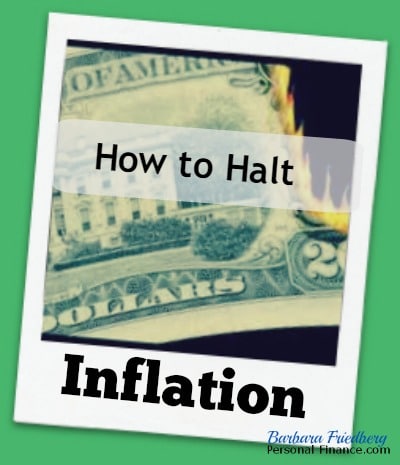Investing Strategy for Inflation and Asset Protection
“Inflation is when you pay fifteen dollars for the ten-dollar haircut you used to get for five dollars when you had hair.”
Sam Ewing, brainyquote.com
Zvi Bodie and Rachelle Taqqu authored the revolutionary Risk Less and Prosper book about life cycle investing. This book flips conventional investing wisdom on its head and begins the investing conversation with your goals. The authors continue the discussion with ideas to protect your precious capital from the ravages of inflation and from the volatility of the financial markets.

Conventional investing advice recommends choosing an asset allocation, for example 60 percent in stock index mutual funds and 40 percent in bond mutual funds, and regularly transferring money from your paycheck into these funds. This strategy assumes that in spite of the ups and downs of the investment markets, when its time to retire, you’ll have a nice nest egg saved up to supplement social security. It sounds nice and easy; actually, I’m a big proponent of the traditional approach.
So, what inspired me to bring up this topic which is contrary to the traditional investment ideas promoted on this website?
There is More Than One Way to Save for Retirement
Safety First
What if you devised an investment plan that was likely to meet your basic living expenses? And instead of allocating lots of money into stock market investments, you decided to save up the minimum you require in retirement and kept those funds safe and secure from the ravages of inflation? During the first couple of decades of the millennium, with historically low interest rates, this method would have been flawed.
But, as interest rates begin rising, and returning to normal levels, Risk Less and Prosper deserves another look.
Conventional investment advisers recommend targeting an amount of retirement dollars and using historical stock and bond market averages to project into the future how to reach that goal. The problem with this approach is that historical returns may not continue into the future. Not only that, but what if you want to retire at the same time that the stock market experiences a cyclical decline in value? In both cases, your retirement dollars will fall short of your minimal living standard.
Life Cycle Investing Offers an Alternative
Life cycle investing protects against the worst case scenario, living longer than your money.
Consider the income from your job, both now and in future years. Tally it up and you may be surprised at the total. If you make $50,000 per year and expect to make that amount for 40 years (a rather simple example), you’ll earn $2,000,000 during your lifetime. That’s an example of your human capital or earning power. Your lifetime goal is to transfer some of that money from your earning years into the future, when you won’t be earning.
Simply put, smooth out your cash flow so that you can reach your current and future spending and lifestyle goals.

What is the Minimum Cost of your Future Living Expenses?
1. Calculate the minimum cost of your retirement lifestyle. With zero interest rates don’t worry about adjusting these numbers.
2. Estimate how much you expect to receive from pensions and social security.
3. Find the difference between your minimum lifestyle expenses and your income, and those are the minimum funds you need for retirement.
By focusing on the estimated costs of living in the future, you have a realistic idea of how many “safe dollars” you’ll need during your retirement. Protect these dollars from inflation and you have a plan to meet a minimum standard of living. If this number is greater than you currently save, consider working a few years longer or saving more.
Any additional funds can be allocated to risky investments such as stocks or real estate funds.
How to Protect Your Funds from Inflation
This approach attacks the problems with traditional retirement investing; your historical returns are too low or you retire during a recession or downturn in the stock market.
I’ve written previously about the importance of inflation protected investing. In the previous investment environment with historically low interest and inflation rates, it seemed unimportant to worry about inflation. Yet, even a low 2 percent annual rate of inflation can reduce the purchasing power of $100 to $54 over 30 years. The underlying premise of preserving your purchasing power and lifestyle from your working years into retirement is grounded in the theory that your safe dollars will cover your living costs into the future.
With the highest inflation rates since the 1980’s, government inflation protected bonds are the way to go.
Treasury Inflation Protected Securities and Government I Bonds shield your purchasing power against inflation. Invest your savings in these two investments and protect your minimum standard of living throughout your lifetime.
With growing inflation, Government I Bonds are a high yield, safe investment.
In May 2023 through October 2023, the I bond fixed interest rate is 4.3%.
The beauty of I bonds is that the return adjusts every 6 months to account for changes in inflation. When inflation increases, so will the return on I bonds. Buy $10,000 (the maximum amount allowed by the government) of I bonds annually over your working life and at the end of 40 years, you have $400,000.
This $400,000 is adjusted for inflation and is not subject to the ups and downs of the stock market. If you use these funds, along with social security to cover your minimum required expenses you’ll protect the purchasing power of your cash, and avoid the volatile returns of the stock market.
Any additional savings can be invested in the stock market without fear of outliving your minimal retirement expenses.
Related
- 10 Best Alternative Investments
- Zvi Bodie
- Risk Less and Prosper
- Which Investment Carries The Least Risk
- Six Dangerous Investing Myths
- Retirable Review
- Should I In A Muni Bond Portfolio?
Disclosure: Please note that this article may contain affiliate links which means that – at zero cost to you – I might earn a commission if you sign up or buy through the affiliate link. That said, I never recommend anything I don’t personally believe is valuable.
Empower Advisors Corporation (“PCAC”) compensates Wealth Media, LLC. (“Company”) for new leads. Wealth Media is not an investment client of PCAC.

